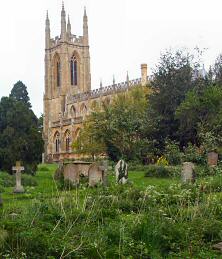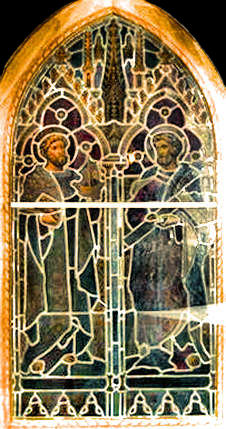|
Index...
|

 n typically defiant fashion, some of the original stained glass hung on to the tracery to survive the onslaught of the blitz, as is shown by this lovely photo below of a window in the north wall, taken by my wife, Bev.
n typically defiant fashion, some of the original stained glass hung on to the tracery to survive the onslaught of the blitz, as is shown by this lovely photo below of a window in the north wall, taken by my wife, Bev.
In the early part of the war leading up to the blitz, the potential threat to the cathedral during air-raids was fully realized, and certain measures to preserve the building's heritage were undertaken. One such measure was to remove the more valuable medieval stained glass, which occupied the two outer windows of the apse and parts of the clerestory, leaving behind the simple geometrically patterned glass.


At a cost of £600 and several months of work, much of the glass in the apse and the clerestory windows above the nave was removed and stored in various places, including the rectory in Hampton Lucy, near Stratford (pictured top right). Much of the glass originated from the 1400s, and although £600 for such an exercise doesn't seem a large sum today, with inflation it would be worth over fifty times that figure in the early 21st century.
Some of the saved glass is now stored in the undercroft of the New Cathedral. I've put together a montage on the right containing seven of the pieces displayed there in St. Michael's Hall.
For more than 70 years there was a commonly held belief that the Victorian era stained glass, formerly occupying the three large central windows of the apse, had mysteriously disappeared and ended up with an antiques dealer in London. From there it had apparently been sold to an Icelandic dealer named Helgi Zoega, who then sold on the glass back in Iceland.
Some of this glass ended up in the Church of Askirkja, in Reykjavik, while other pieces were installed in the Church of Akureyri.
On the 2nd March 2014 a BBC television programme, presented by Dr. Jonathan Foyle, investigated the apparent disappearance of the cathedral's Victorian stained glass. The conclusion was quite astonishing and left little room for doubt.... the glass that was taken to Iceland was almost certainly not from Coventry Cathedral! We can not yet be 100% certain, however, and as David McGrory reminds us; without photographs of other cathedral windows that were not documented it is not possible to come to a definitive conclusion.
With the help of archived records and eye-witness accounts, the BBC show demonstrated the likelihood that the Victorian era glass was left behind in the cathedral to face its eventual destruction on the 14th November 1940. In fact, fragments of the glass might possibly still be present among the piles of rubble that, amazingly, are still only yards from where it originally lay after that fateful night. Much of the rubble, it transpires, was simply swept into unused undercrofts. Perhaps one day someone will get the opportunity to sift through it and locate the evidence that has been sorely missing for over seven decades.
Despite the revelation in 2014 that the Icelandic churches of Askirkja and Akureyri almost certainly do not contain Coventry's glass, friendships and connections have been struck between the two places, and I would still like to display here the beautiful windows that adorn those two churches.


On the left is one of the beautiful stained glass windows, which sits proudly in the Church of Akureyri, Iceland. (See the interior view below showing how this piece fills the central window.)
The piece on the right is another lovely example, and this can now be seen in the Church of Askirkja, which is in Reykjavik, Iceland.
Below are another six examples of glass that belong to the Church of Askirkja.

|

|

|

|

|

|
 The Icelandic lady who has so kindly sent me all these photographs tells me that the church was originally built to imitate a ship, the south side of which is depicted here, representing the stern. She also teaches us that "Askirkja" means the church on the hill, derived from the Icelandic word "As" meaning hill.
The Icelandic lady who has so kindly sent me all these photographs tells me that the church was originally built to imitate a ship, the south side of which is depicted here, representing the stern. She also teaches us that "Askirkja" means the church on the hill, derived from the Icelandic word "As" meaning hill.
 The north entrance to the Church of Askirkja, from where you can see the position of the originally English glass just inside the main doors.
The north entrance to the Church of Askirkja, from where you can see the position of the originally English glass just inside the main doors.
In addition to these beautiful pieces of glass, which have been put to such wonderful use in contemporary Icelandic churches, one piece of the mysterious stained glass ended up being installed in someone's house not far from Askirkja. An Icelandic journalist has written an article about the glass.
 Many thanks go to Andrew Charters for sending me this beautiful interior view of apse in the Church of Akureyri, proudly featuring the glass originally thought to be from Coventry Cathedral in the central aperture.
Many thanks go to Andrew Charters for sending me this beautiful interior view of apse in the Church of Akureyri, proudly featuring the glass originally thought to be from Coventry Cathedral in the central aperture.
To help us to understand the journey travelled in pursuit of the truth behind this story, we have the privilege of being able to read a paper written by Canon Kenyon Wright, who has been closely involved in the Icelandic story, and has kindly allowed me to publish it.
Website by Rob Orland © 2002 to 2025